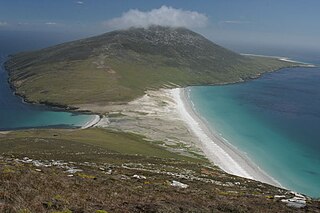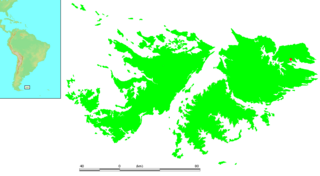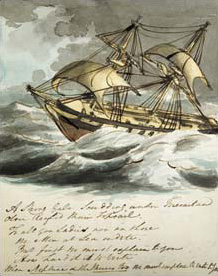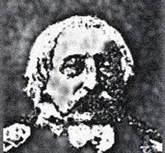
The history of the Falkland Islands goes back at least five hundred years, with active exploration and colonisation only taking place in the 18th century. Nonetheless, the Falkland Islands have been a matter of controversy, as they have been claimed by the French, British, Spaniards and Argentines at various points.

East Falkland is the largest island of the Falklands in the South Atlantic, having an area of 6,605 km2 or 54% of the total area of the Falklands. The island consists of two main land masses, of which the more southerly is known as Lafonia; it is joined by a narrow isthmus where the settlement of Goose Green is located, and it was the scene of the Battle of Goose Green during the Falklands War.

Saunders Island is the fourth largest of the Falkland Islands, lying north west of West Falkland. The island is run as a sheep farm.

Port Louis is a settlement on northeastern East Falkland. It was established by Louis de Bougainville on 5 April 1764 as the first French settlement on the islands, but was then transferred to Spain in 1767 and renamed Puerto Soledad.

The governor of the Falkland Islands is the representative of the British Crown in the Falkland Islands, acting "in His Majesty's name and on His Majesty's behalf" as the islands' de facto head of state in the absence of the British monarch. The role and powers of the governor are set out in Chapter II of the Falkland Islands Constitution. The governor in office resides at Government House, which serves as the official residence.

In December 1832, two naval vessels were sent by the United Kingdom to re-assert British sovereignty over the Falkland Islands, after the United Provinces of the Rio de la Plata ignored British diplomatic protests over the appointment of Luis Vernet as governor of the Falkland Islands and a dispute over fishing rights.
Sovereignty over the Falkland Islands is disputed by Argentina and the United Kingdom. The British claim to sovereignty dates from 1690, when they made the first recorded landing on the islands, and the United Kingdom has exercised de facto sovereignty over the archipelago almost continuously since 1833. Argentina has long disputed this claim, having been in control of the islands for a few years prior to 1833. The dispute escalated in 1982, when Argentina invaded the islands, precipitating the Falklands War.

Luis Vernet was a merchant from Hamburg of Huguenot descent. Vernet established a settlement on East Falkland in 1828, after first seeking approval from both the British and Argentine authorities. As such, Vernet is a controversial figure in the history of the Falkland Islands sovereignty dispute.

Port Egmont was the first British settlement in the Falkland Islands, on Saunders Island off West Falkland, and is named after John Perceval, 2nd Earl of Egmont, who was First Lord of the Admiralty at the time of its founding.

Puerto Soledad was a Spanish military outpost and penal colony on the Falkland Islands, situated at an inner cove of Berkeley Sound.

The Falkland Islands is an archipelago in the South Atlantic Ocean on the Patagonian Shelf. The principal islands are about 300 mi (480 km) east of South America's southern Patagonian coast and about 752 mi (1,210 km) from Cape Dubouzet at the northern tip of the Antarctic Peninsula, at a latitude of about 52°S. The archipelago, with an area of 4,700 sq mi (12,000 km2), comprises East Falkland, West Falkland, and 776 smaller islands. As a British Overseas Territory, the Falklands have internal self-governance, but the United Kingdom takes responsibility for their defence and foreign affairs. The capital and largest settlement is Stanley on East Falkland.

David Jewett was an American-born Brazilian naval officer known for his role in the sovereignty dispute between the United Kingdom and the United Provinces of the Río de la Plata over the Falkland Islands. He was a naval commander in the Quasi-War with France and following the end of that conflict he offered his services as a mercenary in both the United Provinces and the Empire of Brazil. Licensed as a privateer by the United Provinces to seize Spanish ships, he was later accused of piracy following the seizure of American and Portuguese flagged vessels. Jewett finished his career in the Imperial Brazilian Navy, serving under Lord Cochrane and died in Rio de Janeiro in 1842.

The Heroína was a privately owned frigate that was operated as a privateer under a license issued by the United Provinces of the River Plate. It was under the command of American-born Colonel David Jewett and has become linked with the Argentine claim to sovereignty of the Falkland Islands.
There were many events leading to the 1982 Falklands War between the United Kingdom and Argentina over possession of the Falkland Islands and South Georgia.

The Falklands Crisis of 1770 was a diplomatic standoff between Great Britain and Spain over possession of the Falkland Islands in the South Atlantic Ocean. These events were nearly the cause of a war between Britain and Spain—backed by France—and all three countries were poised to dispatch armed fleets to defend the rival claims to sovereignty of the barren but strategically important islands.

The Falkland Islands have a complex history stretching over five hundred years. Active exploration and colonisation began in the 18th century but a self-supporting colony was not established till the latter part of the 19th century. Nonetheless, the islands have been a matter of controversy, as due to their strategic position in the 18th century their sovereignty was claimed by the French, Spaniards, British and Argentines at various points.
William Dickson, born Dublin, Ireland was an Irish-born settler in Port Louis in the Falkland Islands during a pivotal time in its history. He was hired by Luis Vernet as Port Louis storekeeper. Following the removal of the Argentine administration, Dickson was given into custody the British flag. Dickson wrote a diary where he documented the life in Port Louis shortly after the British landing. He became one of the victims of the Gaucho Murders, on 26 August 1833.

José María Pinedo was a commander in the navy of the United Provinces of the River Plate, one of the precursor states of what is now known as Argentina. He took part in the Argentine War of Independence, the Argentine Civil Wars and the Cisplatine War. He is also known for failing to resist the British return to the Falkland Islands in 1833.

The Falklands Naval Station was the main base of the naval component of Argentina in the Falklands Islands, during the South Atlantic conflict of 1982.

Francisco de Paula Bucareli y Ursúa was a Spanish noble, Governor of the Rio de la Plata (1766–1770) and Viceroy of Navarre (1773-1780).















